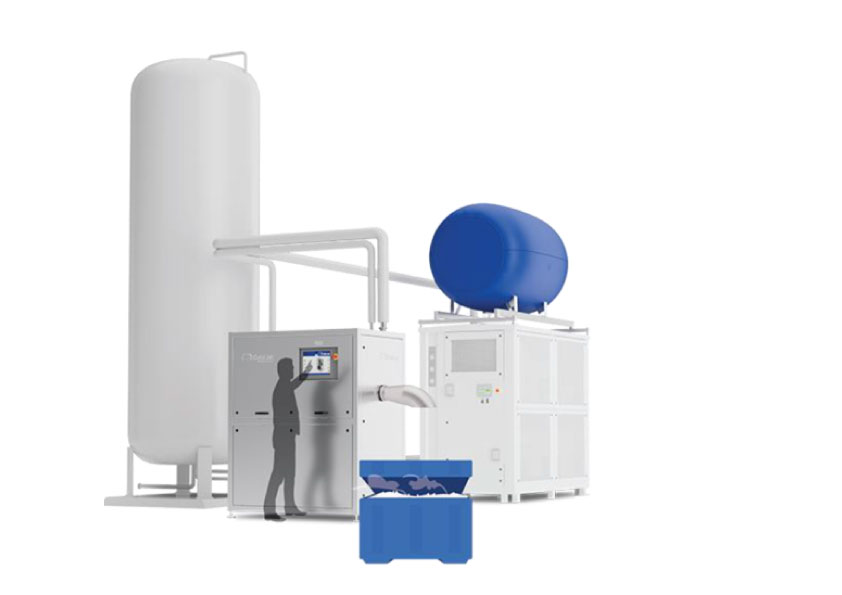Dry Ice Blasting
การทำความสะอาดด้วยน้ำแข็งแห้ง
Dry Ice หรือน้ำแข็งแห้ง คือ ก๊าซคาร์บอนไดออกไซด์ ที่มีอยู่ตามธรรมชาติ นำมาผ่านกระบวนการผลิต โดยให้มีอุณหภูมิ -79 องศาเซลเซียส และเปลี่ยนสถานนะกลายเป็นของแข็ง มีทั้งแบบชนิดก้อนและแบบเม็ด ซึ่งมีคุณสมบัติเด่นคือ ไม่มีกลิ่น, ไม่มีพิษ และเป็นมิตรกับสิ่งแวดล้อม จึงทำให้ปัจจุบัน นิยมนำมาใช้ในการทำความสะอาดในงานหลากหลายประเภทโดยเครื่อง Dry Ice Blasting ในโรงงานอุตสหากรรมต่างๆ
Dry Ice Blasting เป็นวิวัฒนาการใหม่ที่ทันสมัย เหนือกว่าวิธีการทำความสะอาดแบบเดิมๆ อาทิเช่น การใช้แปรงขัดด้วยแรงคน, การพ่นทราย, การพ่นเม็ดพลาสติก, การพ่นด้วยน้ำแรงดันสูง, การใช้สารเคมี หรือ สารละลายต่างๆ ฯลฯ ซึ่งการทำความสะอาดดังกล่าวนั้น มีขั้นตอนที่ยุ่งยาก ใช้เวลานาน และประสิทธิภาพในการทำความสะอาดต่ำ และที่สำคัญ อาจก่อให้เกิดมลภาวะต่างๆมากมาย

โดยเฉพาะการใช้สารเคมีในการทำความสะอาดซึ่งการทำความสะอาดด้วยน้ำแข็งแห้งนั้นเป็นการทำความสะอาดที่ปลอดภัย, รวดเร็ว, ประหยัด และที่สำคัญคือเป็นมิตรกับสิ่งแวดล้อม ซึ่งเป็นเรื่องที่ผู้ผลิตส่วนใหญ่ให้ความสำคัญเป็นลำดับต้นๆ
Dry Ice Blasting เป็นการนำเอาน้ำแข็งแห้ง มาพ่นด้วยเครื่องพ่นแรงดันสูง พ่นออกมาด้วยความเร็วเหนือเสียง และด้วยคุณสมบัติของน้ำแข็งแห้ง สามารถทำให้สิ่งสกปรกต่างๆที่เคลือบอยู่บริเวณพื้นผิวหดตัว และ แตกหักจนหลุดออกมาอย่างง่ายดาย โดยไม่ก่อให้เกิดความเสียหายใดๆต่อชิ้นงาน และเครื่องจักร และที่สำคัญจะไม่ทิ้งของเสียจากการทำความสะอาด เนื่องจาก น้ำแข็งแห้งจะระเหิดหายไปในอากาศ ดังนั้นจึงเป็นการล้างที่สะอาด, ปลอดภัย และ รักษาสิ่งแวดล้อม ซึ่งปัจจุบันยังไม่มีเครื่องหรือวิธีการทำความสะอาดแบบอื่นมาเปรียบเทียบได้
หลักการทำงานของน้ำแข็งแห้ง มี 3 หลักการตามรูปคือ 1.การเจาะทะลุ 2.การใช้ความเย็น 3.การระเหิด
ซึ่งขึ้นอยู่กับปัจจัยหลักๆดังนี้คือ แรงดันลม, ชนิดของหัวพ่น, ขนาดของน้ำแข็งแห้งและความหนาแน่น และ ปริมาณของน้ำแข็งแห้งที่ใช้


1. น้ำแข็งแห้งถูกพ่นออกมาด้วยลมแรงดันสูง ทำให้เม็ดน้ำแข็งเจาะลงไปยังสิ่งสกปรกต่างๆที่เกาะอยู่บนพื้นผิว
Cold Jet dry ice blasting uses compressed air to accelerate frozen carbon dioxide (CO2) “dry ice” pellets to a high velocity. A compressed air supply of 80 PSI/50 scfm can be used in this process. Dry ice pellets can be made on-site or supplied. Pellets are made from food grade carbon dioxide that has been specifically approved by the FDA, EPA and USDA.
Carbon dioxide is a non-poisonous, liquefied gas, which is both inexpensive and easily stored at work sites.
How does CO2 Blasting Work?
CO2 blasting works because of three primary factors: pellet kinetic energy, thermal shock effect and thermal-kinetic effect. Cold Jet optimizes blast performance for each application by combining these forces and adjusting:
- Compressed air pressureEnvironmentally responsible and contains no secondary contaminants such as solvents or grit media
- Blast nozzle type (velocity distribution)
- CO2 pellet size and density
- Pellet mass rate and flux density (particles per unit area per second)
Pellet Kinetic Energy
The Cold Jet process incorporates high velocity (supersonic) nozzles for surface preparation and coating removal applications. Since kinetic impact force is a product of the pellet mass and velocity over time, the Cold Jet delivery system achieves the greatest impact force possible from a solid CO2 pellet by propelling the pellets to the highest velocities attainable in the blasting industry.
Even at high impact velocities and direct head-on impact angles, the kinetic effect of solid CO2 pellets is minimal when compared to other media (grit, sand, PMB). This is due to the relative softness of a solid CO2, which is not as dense and hard, as other projectile media. Also, the pellet changes phase from a solid to a gas almost instantaneously upon impact, which effectively provides an almost nonexistent coefficient of restitution in the impact equation. Very little impact energy is transferred into the coating or substrate, so the Cold Jet blasting process is considered to be nonabrasive.
Thermal Shock Effect
Instantaneous sublimation (phase change from solid to gas) of CO2 pellet upon impact absorbs maximum heat from the very thin top layer of surface coating or contaminant. Maximum heat is absorbed due to latent heat of sublimation.
The very rapid transfer of heat into the pellet from the coating top layer creates an extremely large temperature differential between successive micro-layers within the coating. This sharp thermal gradient produces localized high shear stresses between the micro-layers. The shear stresses produced are also dependent upon the coating thermal conductivity and thermal coefficient of expansion / contraction, as well as the thermal mass of the underlying substrate. The high shear produced over a very brief expanse of time causes rapid micro-crack propagation between the layers leading to contamination and/or coating final bond failure at the surface of the substrate.
Thermal-Kinetic Effect
The combined impact energy dissipation and extremely rapid heat transfer between the pellet and the surface cause instantaneous sublimation of the solid CO2 into gas. The gas expands to nearly 800 times the volume of the pellet in a few milliseconds in what is effectively a “Micro-explosion” at the point of impact.
The “Micro-explosion,” as the pellet changes to gas, is further enhanced for lifting thermally-fractured coating particles from the substrate. This is because of the pellet’s lack of rebound energy, which tends to distribute its mass along the surface during the impact. The CO2 gas expands outward along the surface and its resulting “explosion shock front” effectively provides an area of high pressure focused between the surface and the thermally fractured coating particles. This results in a very efficient lifting force to carry the particles away from the surface.
